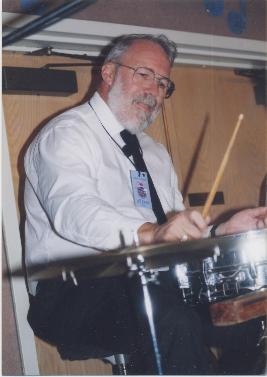1954-1958 (SOUNDS OF YESTERYEAR DSOY853). Playing time: 55m. 22s.
Hollywood Palladium, February 1954
Introduction; Joshua Fit de Battle of Jerico; Don’t Take Your Love from Me; Reverie
in the Rain; You Turned the Tables on Me; Where or When; Stars Fell on Alabama;
Rub-A-Dub-Dub; Blues Theme from An American In Paris; Shaker Heights Stomp;
Sign Off: Where or When
Personnel: John McCormick, Carl Erca, William Wert - trumpets; Ralph Craig,
Marshall Cram, Hale Rood, Harry Street - trombones; Joe Lenza, Leon Hamlin,
clarinets - alto saxes; Louis Cantanzaro, Salvatore Azzolina - clarinets, tenor saxes;
Martin Marks - clarinet, bass sax; Ralph Flanagan - piano; Milton Norman - guitar;
Jack Keys - bass; William C. Smith - drums; Buddy Victor and The O’Day Sisters -
vocals.
Chase Club, Hotel Chase, St. Louis, MO, June 6th, 1958
Intro: (Gene Krupa: Calling Doctor Gillespie); When the Saints Go Marching In; On
the Banks of the Wabash; Twelfth Street Rag; Hot Toddy; My Hero; Sign Off:
Giannina Mia.
Personnel: Ralph Flanagan - piano; others unknown.
Hotel Peabody, Memphis, TN, November 7th, 1958
Intro: Hot Toddy; I’m in the Mood for Love; I Want to Be Happy; Sentimental
Journey; Lazy River; Sometimes I’m Happy; Sign Off: (Gene Krupa: Calling Doctor
Gillespie).
Personnel: Ralph Flanagan - piano; Sheila Jordan - vocal; others unknown.
This CD, the fourth volume of radio broadcasts in this series by the Ralph Flanagan
big band, covers the years 1954-1958. That decade was one which, unknowingly for
many of us at the time, witnessed the twilight of the big bands. In the late forties
there had begun a shift to small groups. Louis Armstrong, for example, abandoned
the big band format in the late forties and went to the All Stars, a seven-piece
group. At the same time, the traditional jazz revival, to which many teenagers were
flocking, was under way, the bands playing such jazz being comprised of six or
seven musicians. Also by the mid fifties rock and roll was making its entrance.
But during the fifties, the big bands, although declining, hung on. Ted Heath, Ray
Anthony, Ray McKinley, Eric Delaney, Billy May, Ralph Flanagan, and many
others were still touring and recording and broadcasting or some combination
thereof. Ballrooms still existed in most cities, and bands came in to play for
dancing, not just concerts. In the U.K. no American bands were able to tour in the
early fifties because of some union squabble, but we did manage to listen to them at
night when, after dark, we could pick up American Forces Network broadcasts from
Germany. Then we would then go to listen to their records—78 r.p.m.—in the
record shop’s listening booth, occasionally buying one when flush.
Among others I would hear Ralph Flanagan’s big band, his big hit being Hot
Toddy. On this disc that number is featured, along with others that were on the hit
parade of the day, including Rub-A-Dub-Dub. Flanagan consciously attempted to
recreate the “Glenn Miller” sound, as is clear on many of the tracks on this CD.
Indeed, the opening track, simply called Introduction, is a thinly veiled reworking
of Moonlight Serenade, and most others try to capture that sound. Perhaps that was
one of the band’s limitations—it developed no sound of its own, no musical
identity, but was more or less another Miller-sounding band, and there was hardly a
shortage of those in the 1950’s, including bands led by former Miller alumni such as
Tex Beneke, Ray McKinley, Ray Anthony, and Jerry Gray. To cap it off, unlike the
Benny Goodman band, for example, there were no “stars” in the Flanagan band.
But despite all of that, the band played eminently danceable music. The
arrangements were crisp: all sections solidly together, brass nicely punched by the
rhythm section, tempos evenly maintained—everything, in short, that ballroom
dancers craved. However, there was no real, separate identity. Yet for a window on
part of the big band scene of the time, this CD serves quite well.
|
|





